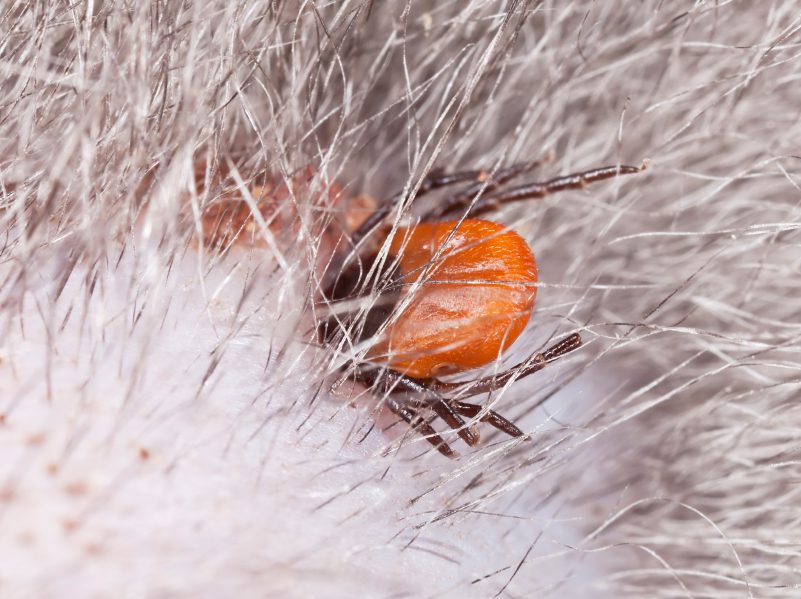
External parasites of cats and dogs

External parasites are a serious and very common problem faced by cat and dog owners. Often, owners underestimate the danger posed by pests. Consider in this article the main types of parasites that can settle on the body of a pet.
Contents
Types of parasites and harm from them
Ixodid ticks
Ticks that live in grass in parks, meadows, and even in the city, and wait for a person or animal to pass by. They can carry piroplasmosis, ehrlichiosis, anaplasmosis, borreliosis, and other diseases. Read an article about ticks.
Demodex
Demodicosis-causing mites of the genus Demodex – D. Canic in dogs, D. Cati and D. gatoi – in cats. Normally, a small number of these species-specific mites live in hair follicles and do no harm. However, under certain conditions, mites begin to multiply excessively, causing unbearable itching, skin damage, scratching, alopecia and the development of secondary infections. The disease does not require enhanced treatment in the juvenile form in puppies, but requires increased attention in the generalized form, in which almost the entire surface of the skin is damaged. Demodicosis is rare in cats and is more commonly associated with an immunosuppressive state.
Ear mite
Microscopic mites Otodectes cynotis, which parasitize in the external auditory canals, causing otodectosis. As a result of the activity of ticks in the ears, microtraumas, irritation, swelling and severe itching occur. The animal is depressed and nervous, it scratches its ears, often the head is turned to the affected side, they shake their heads. Often, with severe itching, the animal itself severely injures the auricle and the surrounding skin around it, and a secondary infection can also join. With severe damage, even death is possible.
Scabies Ticks
Scabies mites of the genus Notoedres cati fam. Sarcoptidae live and reproduce in the thickness of the epidermis. Notoedrosis is a highly contagious disease among cats and rabbits, dogs can become infected, but less often, ticks live mainly on the head, with a strong infection they move to the neck, chest and paws. Ticks from the genus Sarcoptes that feed on dead skin particles, lymph, and serous exudate are more likely to infect dogs. Both types of mites gnaw holes in the skin, cause unbearable itching, serious damage to the skin with the involvement of secondary microflora. The skin thickens, bleeds, later becomes covered with crusts, after about 3 weeks the itching increases sharply, the thickened edematous skin becomes covered with deep cracks, conjunctivitis appears, the animal is lethargic and loses weight. In dogs, anorexia is observed, and in cats, appetite may persist. Without treatment within 2 months the animal dies.
Fleas
95% of fleas live in the environment and only 5% on the animal. These parasites can bite cats, dogs, and people. When bitten, they can infect a pet with infectious diseases. If a flea is accidentally swallowed, a pet can acquire a tapeworm – Dipylidium. Also, many animals often have flea allergic dermatitis, which occurs as a result of the body’s reaction to flea saliva. For old, weakened pets, for puppies and kittens, a serious flea infestation is dangerous with the risk of developing anemia and in some cases even death.
Lice and lice
Lice feed on blood and lymph, lice feed on particles of skin, fluff, secretions of the sebaceous glands. Lice have an elongated body, a narrow small head, they move slowly. Infection occurs through close contact with an infected animal. The animal itches, gets nervous, the quality of the coat deteriorates, dandruff and crusts appear, allergic dermatitis, with a large number of insects in the weak, sick, elderly and young, anemia may develop. Vlas-eaters have a larger head and gnawing mouthparts, they do not drink blood. When they become infected, alopecia is observed, a general deterioration of the coat, dandruff, itching, dermatitis, saliva and secretions cause an allergic reaction. Vlas-eaters choose the area of uXNUMXbuXNUMXbthe tail and head as their habitat on the animal. They are intermediate hosts for the tapeworm Dipylidium. Cats are more likely to be found with lice (often along with other types of parasites).
Mosquitoes, flies
These insects do not constantly parasitize the animal. Mosquitoes can infect a pet with heartworms – dirofilaria. Not all types of flies are capable of biting. But those flies that can, for example, horseflies and zhigalki, bite cats and dogs by the ears and nose. As a result, wounds form, the skin becomes inflamed, itchy, and ichor is released, which attracts flies even more. They can carry such dangerous diseases as tularemia, anthrax, and sometimes lay eggs on the skin and in the wound, where the larvae then develop.
Infestation symptoms and diagnosis
Symptoms of the presence of external parasites in an animal can be different. The main ones include:
- Itching. The animal scratches and gnaws certain parts of the body. Sometimes the itching is so strong that the pet significantly injures the skin, and becomes restless and aggressive.
- Hair loss, dull color. Wool may fall out in small areas, and may affect almost the entire surface of the body.
- Skin damage: peeling, dandruff, redness, rash, blisters and crusts.
Diagnosis is easy when it comes to ixodid ticks, myiasis, or if adult fleas are found on the animal. Otherwise, additional diagnostics is indispensable. To exclude flea infestation, a simple “wet test” is used: comb out the wool over a wet sheet of white paper. With a positive result, small black grains will remain on it, which, when rubbed, leave a red-brown color – these are flea feces, digested blood. To detect microscopic mites, you will need to make a deep and superficial scraping of the skin or a swab from the ear for examination under a microscope. Also, this method is used to monitor the effectiveness of treatment.
Control methods and prevention
The best defense is prevention. To protect your pets from external parasites, you need to remember the basic rules:
- You need to protect all the animals in the house at the same time.
- Do not forget about the regularity, read the instructions for the drugs, which describes the duration of action.
- Two or three days before and also after treatment with drops and sprays, it is not recommended to bathe the animal.
- Examine the animal from time to time, regardless of the type of treatment.
Preparations for the treatment of animals exist in several forms: tablets, drops, spray, collar.
- Tablets for dogs
Bravecto, Simparica, Frontline Nexgard. Tablets that help preventively protect the animal from fleas, ixodid ticks and demodexes. Effective in the treatment of demodicosis. Convenient for owners of several dogs, there is no risk of poisoning when licking each other, as well as for dog owners who often bathe and go to the forest and field. Not applicable to cats.
- Drops
The most common type of flea and tick medication. They are applied to the skin at the withers, the average duration is 1,5-2 months. It is necessary to pay attention to the spectrum of effects of drops: for example, there are those that act against fleas, ticks and helminths (Inspector, Prazicide Complex), those that act against fleas and ticks (Bars, Praktik, BlohNet, Rolf Club, Frontline Combo, Bravecto Spot-on), flea only (Advantage for cats), and mosquito repellant (Advantix). Drops from otodectosis are dripped into the ears according to the instructions.
- Sprays
They are applied to the skin and wool, most often used as an aid for forest walks and the treatment of anti-mite overalls.
- Collars
Collars are both based on essential oils – repellent, and based on chemicals. The validity period, depending on the type, is from 1 to 8, and even 12 months. Foresto and Protecto have the longest validity. The collar should fit snugly against the skin of the animal.
- Shampoos
Shampoos have a lower protective function, but already help with existing parasites. The coat is wetted with water, shampoo is applied, and you need to wait a few minutes, and rinse off.
Active ingredients in insecticides
- Diazinon causes mites and insects to have impaired motor function, paralysis and death. Absorbed into the blood through the skin, in case of overdose and hypersensitivity to the drug, it can cause poisoning and skin irritation.
- Propoxur causes mites and insects to have impaired motor function, paralysis and death. Practically not absorbed into the skin, less toxic than diazinon.
- Amitraz – causes overexcitation, paralysis and death in ticks, has repellent properties, forcing insects to leave the body of the animal. Doesn’t work on fleas.
- Permethrin, deltamethrin, flumethrin, cyfluthrin – causes paralysis and death in ticks and insects. There are repellent properties. They spread through the fatty layer on the skin and accumulate in the sebaceous glands, practically without penetrating into the blood. May be dangerous to cats.
- Fipronil, piriprol – causes overexcitation and death in ticks. It has a high anti-mite efficiency, but does not have a repellent effect.
- Fluralaner, sarolaner, afoxolaner – are used in tablets, being absorbed in the gastrointestinal tract, reaching the systemic circulation. Caused in ticks and fleas causing uncontrolled neuromuscular activity, paralysis and death. These substances are exclusively intestinal action, they act after the parasite begins to drink blood from the animal. Do not apply to cats, animals less than 1,5 kg. and under 8 weeks of age.
- Imidacloprid – blocks the transmission of nerve signals in fleas, does not affect ticks. Accumulates in hair follicles, safe for pets.
- Selamectin – blocks the transmission of nerve signals in insects, acts on fleas, ear and sarcoptic mites, and also acts on the helminths Toxocara and hookworm. It is used for the prevention of dirofilariasis.
- Ivermectin, moxidectin – act on subcutaneous mites and some types of helminths. For herding dogs (collies, shelties, bobtails, Aussies, kelpies, German shepherds, white Swiss shepherds, border collies, bearded collies and their mestizos) that have a mutation in the MDR1 gene, leading to intolerance to this group of substances, it can be deadly .
- Methoprene, juvemon, novaluron, pyriproxyfen are juvenile hormones that disrupt the normal development of parasite larvae. Doesn’t work on ticks. They are usually used in combination with other drugs.
In many cases, you can not self-medicate, especially when infected with subcutaneous and ear mites. Treatment prescribed by a veterinarian is required. When processing and treating an animal already infected with parasites, not only the animal is processed, but also the territory/room. For this, all cracks, furniture, skirting boards, carpets are vacuumed first. Then you need to treat with special insecticides: Bolfo, Parastop, Delcid, Entomosan.





